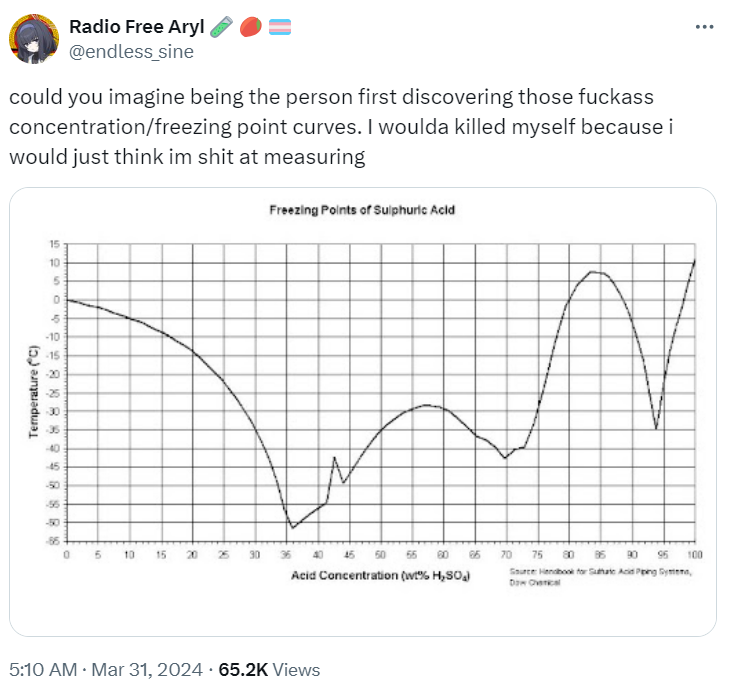this post was submitted on 03 Apr 2024
1008 points (99.7% liked)
Science Memes
10348 readers
1466 users here now
Welcome to c/science_memes @ Mander.xyz!
A place for majestic STEMLORD peacocking, as well as memes about the realities of working in a lab.

Rules
- Don't throw mud. Behave like an intellectual and remember the human.
- Keep it rooted (on topic).
- No spam.
- Infographics welcome, get schooled.
Research Committee
Other Mander Communities
Science and Research
Biology and Life Sciences
- !abiogenesis@mander.xyz
- !animal-behavior@mander.xyz
- !anthropology@mander.xyz
- !arachnology@mander.xyz
- !balconygardening@slrpnk.net
- !biodiversity@mander.xyz
- !biology@mander.xyz
- !biophysics@mander.xyz
- !botany@mander.xyz
- !ecology@mander.xyz
- !entomology@mander.xyz
- !fermentation@mander.xyz
- !herpetology@mander.xyz
- !houseplants@mander.xyz
- !medicine@mander.xyz
- !microscopy@mander.xyz
- !mycology@mander.xyz
- !nudibranchs@mander.xyz
- !nutrition@mander.xyz
- !palaeoecology@mander.xyz
- !palaeontology@mander.xyz
- !photosynthesis@mander.xyz
- !plantid@mander.xyz
- !plants@mander.xyz
- !reptiles and amphibians@mander.xyz
Physical Sciences
- !astronomy@mander.xyz
- !chemistry@mander.xyz
- !earthscience@mander.xyz
- !geography@mander.xyz
- !geospatial@mander.xyz
- !nuclear@mander.xyz
- !physics@mander.xyz
- !quantum-computing@mander.xyz
- !spectroscopy@mander.xyz
Humanities and Social Sciences
Practical and Applied Sciences
- !exercise-and sports-science@mander.xyz
- !gardening@mander.xyz
- !self sufficiency@mander.xyz
- !soilscience@slrpnk.net
- !terrariums@mander.xyz
- !timelapse@mander.xyz
Memes
Miscellaneous
founded 2 years ago
MODERATORS
you are viewing a single comment's thread
view the rest of the comments
view the rest of the comments

Why it do it like that?
My uneducated gut feeling is that it's due to the ratio of water and how the water molecules interact with the acid. Other acids have similar curves (in that they aren't a smooth curve).
This is correct, and it isn't just associated with acids. It's because of an effect called 'freezing point depression', which is the same reason salt lowers the freezing point of water while raising its boiling point.
There are a few explanations as to why this happens, with the easiest being this: if you add something that can't freeze to something that can, then the whole thing will need to lose more energy to allow the whole mass to solidify because the un-freezing stuff physically interferes with the attempts of the freezing stuff to bind together.
However, there is also the additional aspect of vapor pressure, which comes into play when adding things that can freeze to another thing that also freezes, but at a different temperature. I don't really understand that at all, so I will pull from the Wikipedia article on it:
The freezing point is the temperature at which the liquid solvent and solid solvent are at equilibrium, so that their vapor pressures are equal. When a non-volatile solute is added to a volatile liquid solvent, the solution vapour pressure will be lower than that of the pure solvent. As a result, the solid will reach equilibrium with the solution at a lower temperature than with the pure solvent. This explanation in terms of vapor pressure is equivalent to the argument based on chemical potential, since the chemical potential of a vapor is logarithmically related to pressure. All of the colligative properties result from a lowering of the chemical potential of the solvent in the presence of a solute. This lowering is an entropy effect. The greater randomness of the solution (as compared to the pure solvent) acts in opposition to freezing, so that a lower temperature must be reached, over a broader range, before equilibrium between the liquid solution and solid solution phases is achieved. Melting point determinations are commonly exploited in organic chemistry to aid in identifying substances and to ascertain their purity.
So, TL;DR is that chemistry is weird, things react weird at the molecular level because of energy states, and that is what allows us to make ice cream!
Thanks for the extra info. I figured it applied across many solutions. And your TLDR was my initial response - chemistry...well physics in general to cover everything else too, is weird.
The particular acid (sulfuric acid) in the graph is especially complicated b/c it has three different protonation states that are favored at different pHs. Other acids (like nitric, for example) at least only have two protonation states to worry about...
There are a lot of different mechanisms but basically the water and acid together form a weak bond that is harder to freeze than each separately until it reaches a point that the ideal ratio is passed over, then the trend reverses, and the jumps are the molecules becoming reactive again because it turns out Sulfuric Acid is pretty volatile stuff. Also, when fully dissolved, the atoms of some molecules can lose their ionic bonds and instead bond loosely with the water itself, allowing them to have different properties than the solute alone and that would explain why a solution of many elements would have multiple peaks on a graph of their properties.
molecules be getting freaky with it fr fr